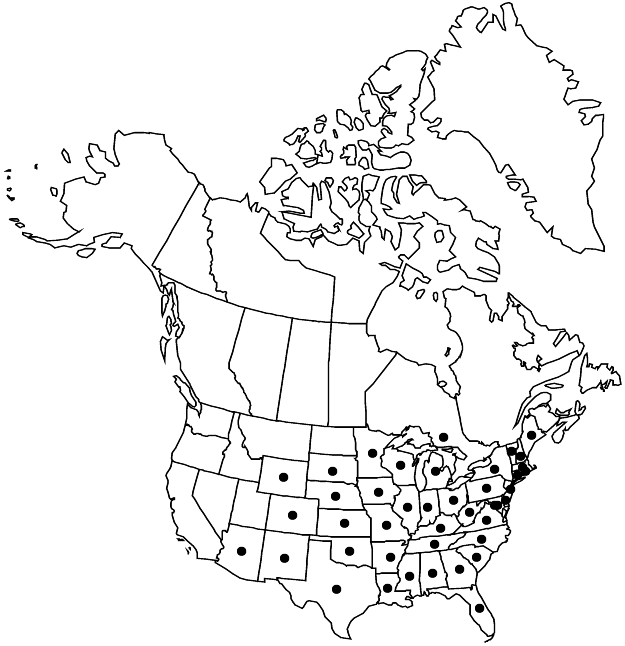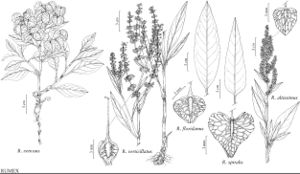Difference between revisions of "Rumex altissimus"
Class-book Bot. ed. 2, 477. 1847.
FNA>Volume Importer |
imported>Volume Importer |
||
| (One intermediate revision by the same user not shown) | |||
| Line 8: | Line 8: | ||
}} | }} | ||
|common_names=Tall or pale dock | |common_names=Tall or pale dock | ||
| + | |special_status={{Treatment/ID/Special_status | ||
| + | |code=W | ||
| + | |label=Weedy | ||
| + | }}{{Treatment/ID/Special_status | ||
| + | |code=F | ||
| + | |label=Illustrated | ||
| + | }} | ||
|basionyms= | |basionyms= | ||
|synonyms= | |synonyms= | ||
| Line 47: | Line 54: | ||
|publication title=Class-book Bot. ed. | |publication title=Class-book Bot. ed. | ||
|publication year=1847 | |publication year=1847 | ||
| − | |special status= | + | |special status=Weedy;Illustrated |
| − | |source xml=https:// | + | |source xml=https://bitbucket.org/aafc-mbb/fna-data-curation/src/2e0870ddd59836b60bcf96646a41e87ea5a5943a/coarse_grained_fna_xml/V5/V5_1039.xml |
|subfamily=Polygonaceae subfam. Polygonoideae | |subfamily=Polygonaceae subfam. Polygonoideae | ||
|genus=Rumex | |genus=Rumex | ||
Latest revision as of 22:07, 5 November 2020
Plants perennial, glabrous, with vertical rootstock. Stems erect, rarely ascending, usually producing axillary shoots below 1st-order inflorescence or at proximal nodes, 50–90(–120) cm. Leaf blades ovate-lanceolate, elliptic-lanceolate, or lanceolate, 10–15 × 3–5.5 cm, usually ca. 2.5–4 times as long as wide, widest in proximal 1/2, thick, often subcoriaceous, base broadly cuneate, rarely almost rounded, margins entire, flat, apex acute or attenuate. Inflorescences terminal and axillary, terminal usually occupying distal 1/5–1/3 of stem, rather dense, normally broadly paniculate. Pedicels articulated in proximal 1/3, sometimes almost near base, thick, (2–)3–7(–8) mm, usually approximately as long as inner tepals, occasionally slightly longer or shorter, articulation swollen. Flowers 12–20 in whorls; inner tepals with broadly triangular, ovate-triangular, or broadly ovate-deltoid, 4.5–6 × 3–4.5(–5) mm, base truncate or indistinctly cordate, margins entire, apex acute; tubercles (2–)3, equal or subequal, glabrous or minutely rugose. Achenes brown or dark reddish brown, 2.5–3.5 × 1.8–2.3 mm. 2n = 20.
Phenology: Flowering late spring–summer.
Habitat: Swamps, marshes, wet shores, alluvial woods, other wet habitats
Elevation: 0-1800 m
Distribution

Ont., Ala., Ariz., Ark., Colo., Conn., Del., D.C., Fla., Ga., Ill., Ind., Iowa, Kans., Ky., La., Maine, Md., Mass., Mich., Minn., Miss., Mo., Nebr., N.H., N.J., N.Mex., N.Y., N.C., Ohio, Okla., Pa., R.I., S.C., S.Dak., Tenn., Tex., Vt., Va., W.Va., Wis., Wyo., n Mexico, Europe (introduced in Denmark, Sweden, United Kingdom).
Discussion
The name Rumex britannica Linnaeus was misapplied to this species by C. F. Meisner (1856) and some North American authors.
Some records of Rumex altissimus from Arizona and New Mexico may refer to R. ellipticus. Two reports from New Mexico were based on misidentification of R. hymenosepalus.
Selected References
None.
